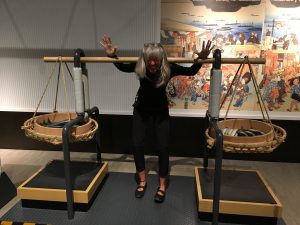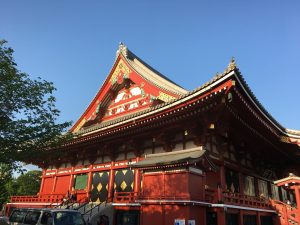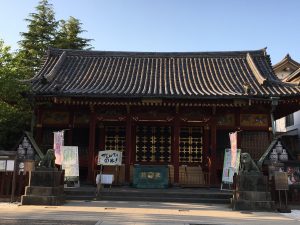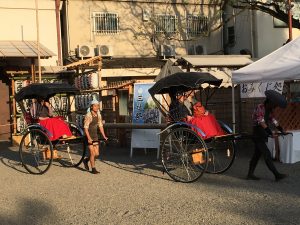I’ve mastered the Tokyo subway system. Or not really. But I did get us to two museums, a shrine and back to the hotel without one wrong turn. Still haven’t figured out all the signage in the stations, because so many of them link to other lines that the overhead neon is lit up with strange characters and colors and symbols. But I’ll settle for being on the right trains for now!
First stop was Roppongi and the National Art Center of Tokyo for a special exhibition: Yayoi Kusama: My Eternal Soul. As a Japanese contemporary artist working in a variety of media her extensive work includes painting, sculpture, film, and installation, unified in its use of repetitive, densely patterned polka dots. Considered a predecessor of Pop Art, she was born on March 22, 1929 in Matsumoto City, Japan and moved to New York in 1958. She quickly established herself as an important member of the avant-garde alongside Warhol, Oldenburg and Eva Hesse. Kusama has explained her use of repetition and polka dots in her work as a means to explore infinity and obsessively negate the self, such as in her immersive installations Infinity Mirror Room (1965), which appeared at the Broad in LA last year. This exhibit was enormous and quite stimulating.
Then, for a complete change of form and function, it was off to Ryogoku. We found a lovely park and bought a box lunch from a small shop and discovered that it was a memorial park to those that died in wars and conflicts and earthquakes. One memorial was dedicated to all those that lost their lives during the American air raids in the 1940’s, another to those lost in Korea. Then it was off to the Edo-Toyo Museum’s permanent exhibit of the history of Edo/Tokyo and displays of miniatures of the the original city. It is an enormous exhibit, covering topics as diverse as the living conditions of the diamyos that served the shogunate, to the fashions and entertainment of the time. There was a brief section on Tokyo during the air raids of the 1940’s and the destruction of Tokyo, but it was mainly in service to show how quickly the city and the nation rebuilt. The miniatures were very impressive and the breadth of the collection was truly eye-opening. Three hours there barely gave us the ability to absorb it all.
Then off to Asakusa to the Sensoji Shrine. This area of Tokyo developed around this oldest Buddhist temple in town. The history of the area has been one of entertainment, and even when rebuilt after being bombed to ashes in WWII, it was re-built with narrow streets and low-roofed houses huddled around the temple. The imposing Kaminari-mon “Thunder Gate” was built as both a gate and a place for storage of treasures for the temple. The narrow streets leading up to the gate are filled with shops selling Japanese sweets and the smell of fresh baked cookies and something called an ice-cream burger filled the air. There were some young women in kimonos and families out for evening strolls and treats since we are in the Golden Week national holiday time.
We braved a local restaurant, choosing our dinner mostly by photo and were pleasantly surprised by both the meal and the experience. And then it was back on the subway and to Shinjuku. And planning for another day.


















